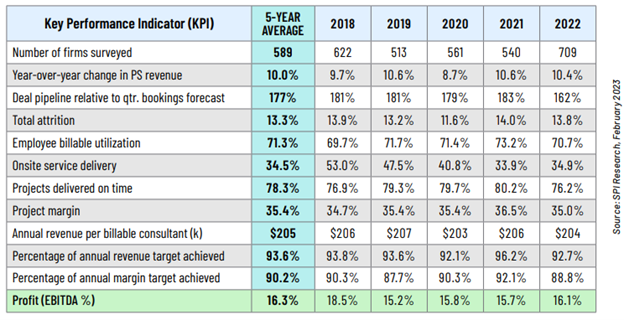Is Your IT Consultancy Missing the Warning Signs?
Use five service performance pillars to learn how your company matches up on its path to operational maturity.
April 5, 2023

By Michael Speranza

Michael Speranza
The performance of IT consultancies over the last three years has been remarkably consistent. According to the 2023 edition of Service Performance Insight’s (SPI) annual Professional Services Maturit Benchmark report, which analyzes the performance of over 700 professional services businesses, IT consultancies – both independent professional services organizations (PSOs) and embedded services organizations (ESOs) – have held steady in terms of sustaining growth and delivering profits.
These are notable accomplishments considering the impacts the chaos of the pandemic, record-high inflation, volatile stock markets and the looming threat of a recession have wrought over the global economy. But the positive statistics mask a worrisome trend.
Red Flags
Almost all key performance indicators (KPIs) associated with service delivery went down in 2022. These include average employee billable utilization and project margins falling below their five-year averages, the number of projects delivered on time dipping by 5%, and project overruns increasing by 21%. As the report states, “services delivery is where profit is made in professional services. If PSOs cannot improve margins in 2023, it will be difficult to grow in 2024.”

“One might say PSOs worked harder in 2022, but not necessarily smarter,” states the SPI report. “The fact that many performance metrics deteriorated, albeit in a minor way, serves as a warning bell to PS executives. The market continues to evolve, and the focus in 2023 must return to improved project and services delivery.”
The SPI report advises PS executives on increasing the use of standardized (or structured) delivery methodologies to improve service execution and explains how doing so will help project managers improve work at a task level and implement quality checks.
One key recommendation is for all PSOs to do the same thing that IT consultancies do every day for their customers: implement technologies that can help them streamline their operations, improve productivity levels and accelerate growth.
More PSOs Embrace PSA
PSOs have the data they need to quantify performance as they accelerate growth and drive to profitability. Data that reveals whether project teams are understaffed flags risks of blown deadlines or budgets and predicts how the business-development pipeline will affect future revenue growth. But before they can use the data, they have to find it. That presents a challenge because the datasets are typically scattered across spreadsheets, horizontal ERP and CRM solutions, project-management solutions, time-tracking tools and other applications.
Solving that challenge has fueled the adoption of professional services automation (PSA) software solutions that SPI defines as tools that “provide the systems basis for initiation, planning, resource management, scheduling, execution, close and control of projects and services (to) help manage service delivery by overseeing opportunities, staffing, project management and collaboration.”
The SPI report highlights the relationships between higher performance and adopting technology solutions designed specifically for professional services organizations. For PSOs with more than 50 employees, the difference between businesses using a tool in SPI’s PSA category and those not using such a tool is significant. Adopters of PS-specific solutions, for example, enjoy a …
… 5% difference in average billable utilization and a 16% difference in average project margins.
The Top Performers
SPI designates the top 20% of benchmark participants as high-performance PSOs (HPPs) for their excellent performance. Over 83% of HPP firms use PSA solutions, and about half have it integrated with their core financial management solutions and/or their core CRM solutions. Not surprisingly, these high-performance PSOs “have better information visibility than lower-performing firms. SPI Research has discussed for years the importance of information integration. Visibility throughout the PSO ensures everyone is operating with the same information to achieve organizational goals.”
Quantifying Performance with Vertical SaaS
As implementing PSA solutions becomes table stakes for the industry, we are now seeing the next step in the evolution of the PSO technology landscape: the use of vertical software-as-a-service (SaaS) solutions purposely designed around the idea of facilitating the “quantified consultant.”
Smartphones, smartwatches and other personal connected devices have enabled individuals to embrace the concept of the “quantified self” by tracking and measuring various physical and mental aspects of their daily lives to improve their health and well-being. It’s also an idea that individuals can apply to their professional lives, specifically in consulting.
The “quantified consultant” refers to using data and metrics to evaluate the performance of individual consultants within a professional services organization. With the rise of vertical SaaS applications purpose-built for managing large-scale professional services organizations, it is now possible to effectively measure key performance metrics such as project management, resource allocation, cross-team collaboration, billability and project delivery.
Vertical SaaS applications designed specifically for the management of professional services organizations offer a range of features to help business leaders effectively measure the performance of their consultants. These applications allow organizations to track billable hours, allocate resources, monitor project progress and measure cross-team collaboration. They also provide real-time data and insights into key performance metrics, such as project delivery times and resource utilization.
The goal isn’t to create a “Big Brother” environment where the relationship between employers and employees deteriorates into an atmosphere of mistrust and resentment. It’s to help organizations make informed decisions about their operations while helping employees and contractors manage their growth and make progress toward achieving their career development aspirations.
Examining how high-performance professional services organizations (HPPs) use technology to run their businesses is one component of SPI’s analysis of the professional services industry. The benchmark scored all 709 participating firms across five service performance pillars: Leadership, Client Relationships, Talent, Service Execution, and Finance and Operations, to provide information on what high performance looks like across these pillars. The information provides a framework for understanding the sequence of steps required to achieve operational maturity.
Michael Speranza is the CEO of Kantata. He has more than 20 years of private equity experience leading several global software and services companies. You may follow him on LinkedIn or @GoKantata on Twitter.
You May Also Like
